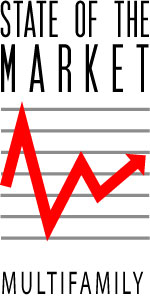|
Subscribe / Renew |
|
|
Contact Us |
|
| ► Subscribe to our Free Weekly Newsletter | |
| home | Welcome, sign in or click here to subscribe. | login |
Real Estate
| |
 |
December 12, 2013
State of the Market: Multifamily rides Seattle’s strong job market
Paragon Real Estate Advisors

Andrews
|

Smith
|
The multifamily asset class has recovered to pre-recession pricing, and investors remain bullish on well-located apartment buildings moving into 2014.
Sales activity
Apartment prices have surged due to lower return expectations, low interest rates, rising rents and relatively stable expense increases.
A recent Dupre + Scott Apartment Advisors report shows sales volume for five-plus units in King, Snohomish and Pierce counties is on track for $2.4 billion in 2013, placing it as the fifth best year on record for total volume. Newer buildings, which rent and sell for more than older buildings, are playing a significant role in increasing sales prices.
Not accounting for newer housing stock (2000 construction or newer), Seattle five-plus unit sales prices are up from $190 per net rentable square foot in 2011 to $235 per net rentable square foot in 2013.

While prices are up, 2013 is projected to have below average sales activity as a percent of the total apartment supply, with only 4.4 percent of the existing stock selling. By contrast, sales activity from 2000 to 2012 averaged 5.3 percent turnover each year.
Demand in the core
The narrowing geographic focus of investors mirrors the locations where tenants want to live, and both are paying premiums to be in these markets. The Capitol Hill/Eastlake submarket has one of the lowest vacancy factors (3 percent) and rents have climbed 9.3 percent over the last 12 months. New apartments are helping to push overall rents in this submarket, as one-bedroom units built after 2008 rent for more than $1,700/month.
Demand for institutional grade product (more than 100 units) demonstrates the willingness to place long-term capital in “core” location assets with strong demand fundamentals and exciting long-term growth stories. These purchases in the core neighborhoods are commonly being placed with conservative down payments or without debt, and have less exposure to interest rate increases in the future.
Two larger sales in the Belltown neighborhood this year set strong pricing marks. Prices were further aided by the proposed Amazon campus to be developed blocks away. Both 206 Bell and the Alto apartments transacted for more than $320,000 per unit and $520 per net rentable square foot. Initial capitalization rates on these transactions are typically occurring in the low 4 percent range.
Non-institutional investors continue to display a strong demand for renovated mid-size apartment buildings (less than 100 units) in the same sought-after locations as institutions. Buyers are looking to place capital where returns and safety are more reliable than other investments. Private investors from California and Canada have been paying premiums to enter the Seattle market, while still achieving yields that are better than the San Francisco, Los Angeles and Vancouver, B.C., markets.
In quality locations, financing for mid-size properties with five- to seven-year terms are still in the 3.5 percent to 4.5 percent interest rate range. Properties are transacting at cap rates between 4.5 percent and 5.25 percent, allowing positive leverage.
Value-add buyers and syndicators who renovated mid-size apartment buildings over the last few years have seen strong returns. With less inventory trading and sales prices up in 2013, many value-add investors are beginning to lose out on purchase opportunities. Long-term-hold investors are willing to pay more and are content with a lower return on investment.
Suburban markets have stabilized from an occupancy standpoint, but aside from Eastside neighborhoods, have yet to see the same rental recovery and transaction activity as core properties. Suburban cap rates remain nearly 200 basis points higher than core product, and will likely continue unless more rent growth develops.
Tech and Millennials
Noted for its good job growth in the tech industry, Seattle is now considered the sixth best real estate market on the Urban Land Institute’s “Markets to Watch” list for 2014. The ULI report also notes that the tech industry will keep wage income growth above the national average.
Amazon, Google and Facebook continue to hire young, educated employees and are paying strong salaries.
A recent report from a company within CareerBuilder ranks the Seattle-Tacoma-Bellevue metro area second in the nation for high-paid job growth, trailing only Washington, D.C. The report anticipates 54 percent of the net jobs gained through 2017 will pay median wages of $21.13/hour and above.
Transaction activity and rent growth is happening in the core submarkets that cater to the Millennial generation. This 20- to 34-year-old age group has a high propensity to be renters, whether by choice, financial obligation or maintaining job mobility. Millennials are choosing neighborhoods with walkable amenities and quick transit access to employment and entertainment centers.
Transit and development
Sound Transit is opening the Capitol Hill and University of Washington light-rail stations in 2016 with access to downtown Seattle, Sea-Tac Airport, and eventually stations in the University District, Roosevelt and Northgate areas. Transit-oriented development is visible around these stations, with significant future development planned for the University District and Roosevelt neighborhoods. Development sites within walking distance to light-rail stations are attracting high prices and multiple offers.
Dupre + Scott predicts nearly 7,000 units will be coming online in the Seattle market for 2014, with another 9,300 in 2015. While developers could oversupply the market, when and by how much is unclear. Seattle’s unemployment rate of only 4.7 percent has allowed new construction properties to lease up faster and at higher rental rates than initially projected. When more apartment supply hits the market in 2014 and 2015, rental concessions and higher vacancy will come into play.
Lenders are still financing new construction in quality neighborhood locations with access to employment centers that do not show a heavy supply of new inventory. Developers with long-term holding plans and higher equity amounts are looked at more favorably. There continues to be some lender pushback in the neighborhoods that are potentially overbuilt.
Outlook
Sales activity should increase in 2014. Buyer demand remains bullish in a low interest rate environment that is expected to continue through next year. Sellers will look to capitalize on new pricing highs and low vacancy rates.
Seattle has a good long-term outlook driven by a strong employment market. The young, educated workforce with strong ties to the tech industry make it a top West Coast destination for both institutional and private investment moving forward.
Travis Andrews and Eric Smith are brokers at Paragon Real Estate Advisors, a leading Puget Sound regional real estate brokerage firm specializing in apartments.
Other Stories:
- Empty strip mall? Here’s how to fill it
- Survey: Urban Visions
- Survey: Thomas Co.
- Survey: Barrientos LLC
- Survey: Wright Runstad and Co.
- Survey: Flinn Ferguson
- Survey: Lake Union Partners
- Survey: Schnitzer West
- State of the Market: Fledgling tech likes ‘gritty’ office buildings
- State of the Market: Is a banner year on tap for industrial properties?
- State of the Market: Retailers cash in on strong local market
- Easements: Not just for highways and driveways
- 40-year-old plan could amp up downtown livability
- Commercial property owners deal with rising flood insurance
- Survey: Wallace Properties


